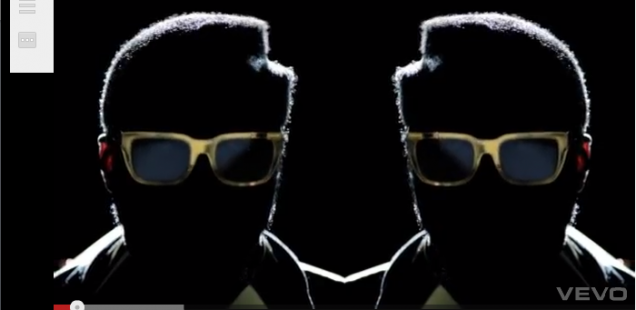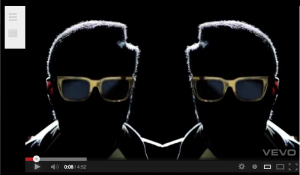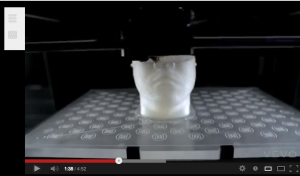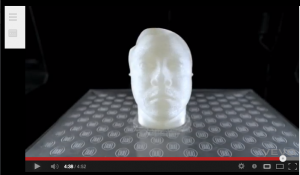
“Britney, bitch” and 4D sonic/affective transmission
OR: superpanoptic data profiling in “Scream & Shout”
[and, as always, this is raw, unrefined writing/work in progress…]
will.i.am & Britney’s “Scream and Shout” does something really musicallyinteresting. The track features Britney: she went into a recording studio to lay down vocals specifically for this track. However, her most musically significant line—that is, what she sings that do the most structural or compositional work in the song, or what she sings at climactic moments—is a sample (or a reperformance meant to sound like a sample) from her 2007 single “Gimme More.” “Scream and Shout” clips the “it’s” from “Gimme More”’s “It’s Britney, bitch,” and cuts this in right before the track’s rather understated drops (e.g., at 1:13-14). So if the most important vocal Britney delivers is actually a sample of one of her earlier songs, why bother to “feature” her, to pay her for a custom vocal? Seems like it would be cheaper to pay for the sample than for a new performance, right? Or, if you want to feature her, why use this sample (or a reperformance that sounds exactly like it was lifted from “Gimme More”)?
Why is this sample presented as what is most definitively Britney? Why is this sample a somehow more full experience of “Britney” than a custom Britney vocal?
The answer is that “Britney” is not Britney Spears, flesh-and-blood person, or even Britney Spears, set of vocal chords. “Britney” is actually the assemblage of all the media (re)presentations of Britney Spears—recordings, paparazzi photos, performances, interviews, etc. “Britney” is a media profile, an assemblage of digital data, .jpegs, mp3s, html, hyperlinks, TV programs and DVD-ed performances, etc. If “Britney” can be said to have an aura in the Benjaminian sense, this aura is not an index or repository of authenticity (the ‘original’ whose provenance we can trace, the authoritative, true iteration of which all others are less-than-perfect reproductions). Instead, “Britney”’s aura is relational and referential—the question is not “is this the REAL Britney” or “is this an accurate re-presentation of Britney” so much as “does this Britney fit in with everything else I know of/about Britney?” or “does it feel or soundlike “Britney”?. In other words, aura is not a measure of individuality, but of fungibility: can this Britney-token be related back to other Britney-tokens? So, the “aura” resides not in Britney Spears, person, but in the “Britney”-archive or “Britney”-database. We recognize the sample as an instance of “Britney”-aura not because it is a direct product of Britney Spears’ labor (it’s not an “authentic” performance), but rather, because it sounds and feels like another recording with which we are already familiar. There is a fungibility of data and a fungibility of affects, which leads to a fungibility between and among data and affects. In the same way that a .jpeg or .wav file can be played on any number of devices, affect can be transmitted and “played” in a cross-platform way…cultural objects like songs or samples are like affect “recordings” that then get sampled and played in various devices (mp3 players, club speakers, etc.). I’m working more on this concept of affective transmission—but to stay on topic, I’ll leave that for another time (though, I will talk about it in my CAA 2013 paper in Feb in NYC…).
The Britney sample is a musical analog to what Steven Shaviro calls the non-indexical character post-cinematic visual media. Conventional notions of “aura”—the idea that reproductions refer back to an original—are indexical in the same way that “cinema” is indexical. As Shaviro explains, “cinema therefore always assumes—because it always refers back to—some sort of absolute, pre-existing space” (17). The film camera records what passed before it IRL. The “Britney”-sample “does not refer back indexically to [Britney Spears’s] body as a source or model. It does not image, reflect and distort some prior, supposedly more authentic, actuality of [Spears]-as-physical presence” (18). It re-presents an already-distortedvocal recording—the referent is the recording, not Spears the person/performer. Spears’s performance in “Scream & Shout” is still indexical—it just indexes a profile—a “complex, aggregated and digitally coded electronic signal” (Shaviro, 19) rather than a subject. Or rather, it understands the subject it references as a profile and not as an “individual.” This profile can be used to generate any number of different “Britney”s.
This read of “Britney”’s presence on “Scream & Shout” reinforces Shaviro’s concept of the postmillennial, “post-cinematic” star: “there is no original, or Platonic ideal, of a celebrity: all instances are generated through the same processes of composition and modulation, and therefore any instance is as valid (or ‘authentic’) as any other” (19). This premise structures pretty much the entire video. On the one hand, images of each star are multiplied: there are both multiple instances of their image in one frame, and their images and/or words are reproduced on various devices (smartphones, digital cameras, tablet computers). On the other hand, their visual and audio profiles are reproduced apart from their visual/material presence. We literally see will.i.am’s profile “generated” through a process of digital fabrication. W’s visual profile, or, more specifically, the “profile” of his double-edged fade cut, is key to his visual iconography/identity in this video. We can tell this is the most important visual representation of W because it appears at the most musically important moment in the video: it is what we see during his stuttered, “nows” preceding “Britney, bitch”. His bust/hair profile is his “image” or “brand.”
This, then, is reproduced by a 3D printer over the course of the video:
Interestingly, his 3D-printed image/profile is directly juxtaposed with the 2D multiplication of W’s image with funhouse-style mirrors.
So visually, the video sets up a contrast between 2D reproduction (the infinite mirroring) and 3D/4D reproduction. 2D visual representation is shown as a technology of copying originals: there’s the foregrounded, flesh-&-blood will.i.am, and then there are first, second, third, n-order reflections of reflections of reflections. It is, in this way, indexical (reflections indexed to other reflections, & ultimately back to an original). The video’s “post-cinematic” 3D/4D production (by ‘production’ I mean both musical/video craftspersonship, and making/manufacturing) is not only not indexical necessarily, or even primarily, visual. We do see plenty of visual manifestations of 3D/4D production: the transmission and transposition of their profile-signals into video images on phones and cameras, into 3D printed models, etc. However, I would suggest that the song’s lyrics, as well as its use of the “Britney” sample, suggest that this 3D/4D production is most optimally (even if not necessarily or sufficiently) sonic.
Let’s look at the lyrics. Britney’s chorus kicks off the song, and her lyrics start by referencing listening, but then talk more extensively about the gaze, before returning to the idea of “scream and shout” as a response to being seen and heard.
When your hear us in the club
You gotta turn the shit up (x3)
You gotta turn the shit up (x3)
When we up in the club
All eyes on us (x3)
See the boys in the club
They watching us (x3)
Everybody in the club
All eyes on us (x3)
I wanna scream and shout and let it all out
And scream and shout and let it out
We sayin’ oh we oh we oh we oh
We sayin’ oh we oh we oh we oh
I wanna scream and shout and let it all out
And scream and shout and let it out
We sayin’ oh we oh we oh we oh
You are now now rocking with
will.i.am and Britney bitch
“Us” first emerge as audio signal—something, presumably this song, that you hear over speakers or a sound system. Only after this do “we” materially/physically/IRL appear in this same space (which makes sense, given the convention in some clubs of simulcasting a song’s video). To be a bit literal here, W & B actually do, materially and physically appear in most clubs across the globe as audio and video signals—their persons are not “in” the clubs where their works are played. This makes the next three sections of the chorus more interesting: perhaps what people see and watch, what they put their “eyes on” is precisely this audio (and maybe video) signal? Are people “gazing” at the song? Or rather, are they watching the data profile that specific types of receivers (speakers, video projectors or screens) output as different types of media? In other words, is the “panopticism” here really superpanopticism (to use Puar’s term), the ‘surveillance’ of data profiles?
I think the surveillance is superpanoptic because the response to this surveillance manifests not visually, but sonically, as the desire to scream and shout. You “let it all out” by overdriving the audio signal. The video equates screaming and shouting to blown speakers: these practices overdrive or “blow” the voice like overly intense signal blows speakers (sometimes, indeed, setting them alight, as I can attest from personal experience). So, W & B appear for others as outputs of digital fabrication processes—either the sculptural fabrication of W’s visage, or the sonic fabrication of their vocal performances. The artists are their data profiles. They can be multiplied on screen (as both B and W are), they can be broadcast on multiple screens (e.g., the camera, the smartphone), they can be reproduced 3-dimensionally (by the printer) and 4-dimensionally (the audio sample, the club speakers). There is one key difference between “Scream & Shout” and Jones’s “Corporate Cannibal,” the video from which Shaviro derives his analysis. In this latter video, Shaviro argues, “Jones’s imagined body is not a figure in implied space but an electronic signal whose modulations pulse across the screen” (Shaviro 16). “Scream and Shout,” however, does not visually depict the signal as such, but material products generated from these signals. Thus, it emphasizes the role of receivers—devices like the 3D printer or the beats by Dre speakers that translate profile/signal into material form. The video and the song themselves can be thought of as “receivers” that translate signal into media perceptible by human eyes and ears—the sample is a materialization of “Britney,” bust a materialization of will.i.am. Human eyes and ears can’t interface directly with binary code or with electronic signals—they’re not within the range of frequencies we can hear or see. The song and the video transpose data-signal into light-signal and/or sound-signal.
So, why use the “Gimme More” sample in a new song featuring a custom Britney vocal? Because in the end it’s all “Britney”-signal, which, to superpanopticism, is all the same anyway. Including the recognizable sample with the new performance clearly situates the new data with respect to the older, already-legible data. It encourages listeners to associate their affective responses to the older data with the new data. As I have shown, the visual content of the video is about precisely this sort of “transmission” and superpanoptic listening.
Remaining questions:
1. How exactly does this use of “data profiles” (.wav files, digital fabrication specs, etc.) transmit affect, i.e., implicit knowledge? How then is this transmission of implicit knowledge actually sort of like a form of disciplinary power, maybe? Is this using biopolitical tech/means to produce disciplinary effects/ends?
2. What’s the significance of the use of “receivers” to translate data/signal into material form? Any relation to increasing shift from “virtual reality” to “mixed reality”?
3. What about recent spate of other “Scream” songs—Usher, Kelis…others? “Scream” as overdrive, response specifically to sine-wave form of biopolitical management?
4. WTeffingF is up with Brit’s faux-English accent? If anyone can please explain this, you win the internet for the day.




I’ve been wondering what the hell is up with that accent since I first heard the song; or, rather, since the second time I heard the song and realised that the women with the strange accent was actually Britney. Maybe that is the point – the accent serves to defamiliarise the new, “live” Britney sections, making it all the more clear that the sample-Britney is the actual Britney. And does that suggest that the “post-cinematic” indexicality isn’t yet quite secure, that listeners (or at least some listeners) still need to be pushed a little bit to hear the song on those terms?
thanks, voyu–that makes a lot of sense!
It has been some time since I visited website with such high quality informationcustom video productions
I find many useful things herewithVideo Animation
This post has a lot of valuable content regarding 2D animation. I appreciated your efforts and ideas that you’ve put in this blog. Big thanks. custom video productions